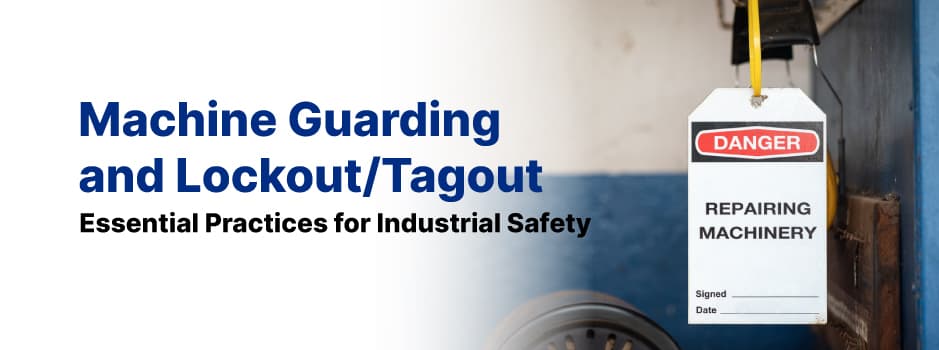Introduction
Machine guarding and lockout/tagout are critical components of industrial safety, helping to prevent accidents, injuries, and fatalities related to machinery use and maintenance. This guide will provide an overview of these essential practices, discuss the regulatory requirements associated with machine guarding and lockout/tagout, and offer practical tips for implementing effective safety measures in your workplace.
Section 1: Machine Guarding
1.1 Understanding the Importance of Machine Guarding
Machine guarding is the practice of using physical barriers or devices to protect workers from hazards associated with the operation, maintenance, and repair of machinery. Proper machine guarding is essential for preventing accidents such as:
- Injuries caused by moving parts, such as cuts, amputations, or crush injuries
- Flying debris or particles, which can cause eye injuries, lacerations, or puncture wounds
- Exposure to hazardous substances or high temperatures, which can result in burns, chemical injuries, or respiratory issues
1.2 Types of Machine Guards
There are several types of machine guards, each designed to address specific hazards or applications. Common types of machine guards include:
- Fixed guards: Permanent or semi-permanent barriers that provide a physical separation between the worker and the hazard
- Adjustable guards: Barriers that can be adjusted to accommodate different operations or machine configurations
- Interlocked guards: Devices that automatically shut down the machine when the guard is removed or opened
- Self-adjusting guards: Guards that automatically adjust to the size or position of the material being processed
- Presence-sensing devices: Sensors or controls that detect the presence of a worker in a hazardous area and automatically stop the machine
1.3 Regulatory Requirements for Machine Guarding
Machine guarding is subject to regulatory requirements, such as those established by the Occupational Safety and Health Administration (OSHA) in the United States. Key requirements include:
- Providing machine guards for all machinery with exposed moving parts or other hazards that can cause injury
- Ensuring that guards are designed, installed, and maintained to effectively prevent worker exposure to hazards
- Providing training and instruction for workers on the proper use and maintenance of machine guards
Section 2: Lockout/Tagout
2.1 Understanding the Importance of Lockout/Tagout
Lockout/tagout is the practice of isolating and securing energy sources during the maintenance, repair, or servicing of machinery to prevent the unexpected startup or release of stored energy. Implementing effective lockout/tagout procedures is essential for preventing accidents such as:
- Injuries caused by the unexpected startup of machinery, including cuts, amputations, or crush injuries
- Electrical injuries, such as shocks, burns, or electrocution
- Exposure to hazardous substances or high-pressure releases, which can result in burns, chemical injuries, or respiratory issues
2.2 Components of a Lockout/Tagout Program
A comprehensive lockout/tagout program should include the following components:
- Procedures: Develop written procedures for the safe isolation and securing of energy sources for all machinery in the workplace
- Training: Provide training and instruction for all workers who perform or are affected by lockout/tagout procedures, ensuring they understand the purpose, hazards, and methods associated with the process
- Devices: Supply appropriate lockout/tagout devices, such as locks, tags, and other equipment, to securely isolate and control energy sources
- Inspection and Monitoring: Regularly inspect and monitor the implementation of lockout/tagout procedures to ensure compliance and effectiveness
2.3 Regulatory Requirements for Lockout/Tagout
Lockout/tagout is subject to regulatory requirements, such as those established by OSHA in the United States. Key requirements include:
- Developing, implementing, and enforcing a written lockout/tagout program for the workplace
- Providing training and resources for workers to effectively perform lockout/tagout procedures
- Conducting periodic inspections and audits to ensure compliance with lockout/tagout requirements and identify areas for improvement
Section 3: Implementing Machine Guarding and Lockout/Tagout in the Workplace
3.1 Assessing Hazards and Identifying Solutions
Begin by conducting a thorough assessment of the hazards associated with machinery in your workplace, and identify appropriate machine guarding and lockout/tagout solutions for each hazard. This process should involve:
- Inspecting and documenting all machinery with exposed moving parts, hazardous energy sources, or other risks that can cause injury
- Evaluating the effectiveness of existing machine guards and lockout/tagout procedures, and identifying areas for improvement
- Collaborating with machine operators, maintenance personnel, and safety experts to develop and implement practical and effective safety solutions
3.2 Training and Education
Provide comprehensive training and education for all workers who operate, maintain, or repair machinery, ensuring they understand the hazards associated with their tasks and are competent in the required safety procedures. This includes:
- Educating workers on the risks and hazards associated with machinery, as well as the importance of following machine guarding and lockout/tagout procedures
- Providing hands-on training in the proper use and maintenance of machine guards and lockout/tagout devices
- Offering refresher training to reinforce key concepts and ensure workers remain knowledgeable about industrial safety best practices
3.3 Continuous Improvement
Regularly review and update your machine guarding and lockout/tagout practices to ensure they remain effective and reflect any changes in your workplace, industry standards, or regulatory requirements. This includes:
- Analyzing incident reports, inspection findings, and feedback from workers to identify areas for improvement in machine guarding and lockout/tagout procedures
- Incorporating lessons learned from actual incidents or near misses to enhance the effectiveness of your safety measures
- Staying informed about industry best practices and regulatory updates related to machine guarding and lockout/tagout, and updating your policies and procedures accordingly
Conclusion
Machine guarding and lockout/tagout are essential practices for ensuring industrial safety and protecting workers from the hazards associated with machinery use and maintenance. By assessing risks, implementing effective safety measures, and providing comprehensive training and education, organizations can prevent accidents, injuries, and fatalities in the workplace.

